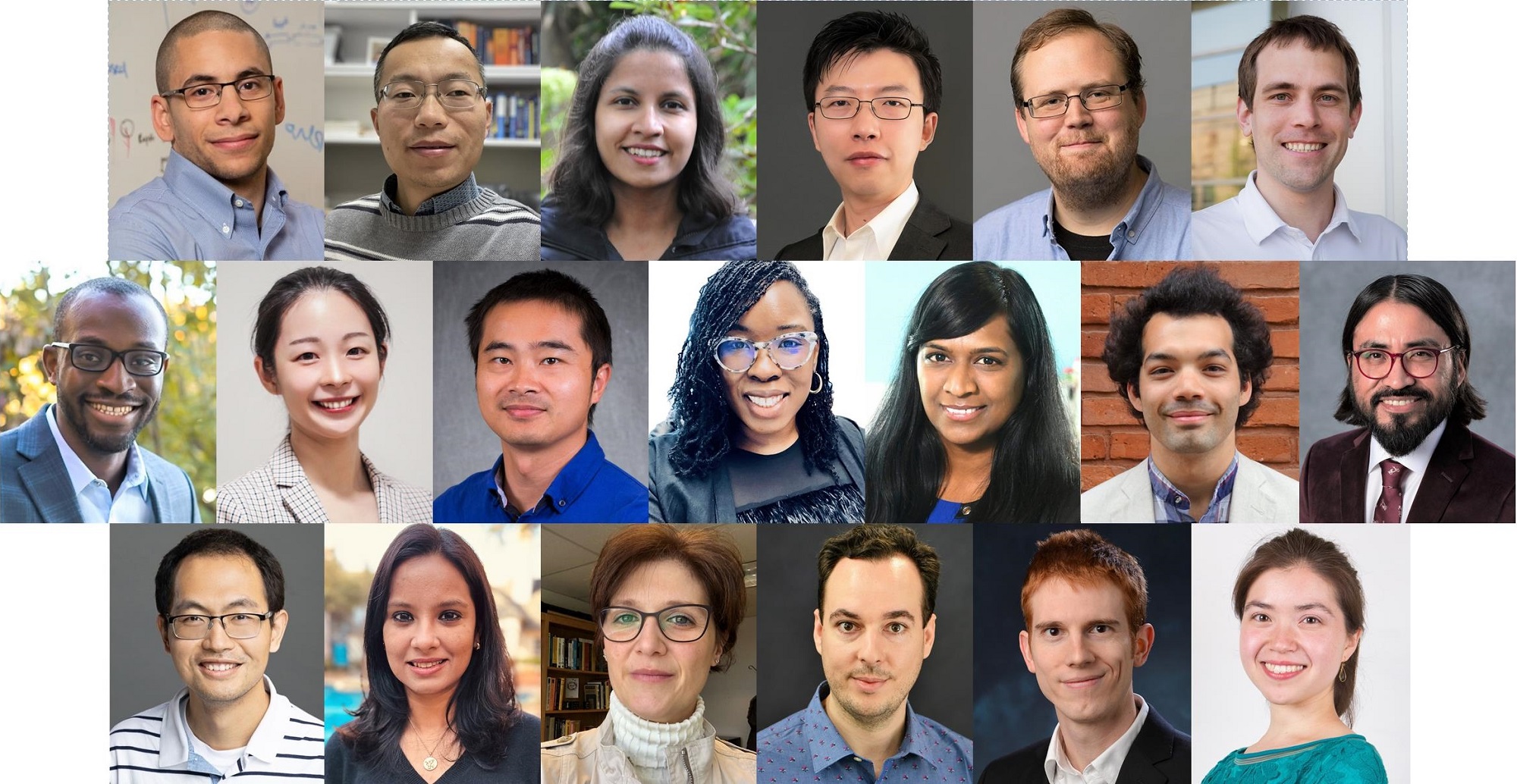7 Team Projects Funded in 3rd Year of Scialog: Negative Emissions Science

Top row: Ahmed Badran, Jimmy Jiang, Shaama Mallikarjun Sharada, Yuanyue Liu, Phillip Milner, Marcel Schreier. 2nd row: Chibueze Amanchukwu, Yayuan Liu, Houlong Zhuang, Kandis Leslie Abdul-Aziz, Mita Dasog, Will Bowman, Jose Mendoza. 3rd row: Hang Ren, Anindita Das, Simona Liguori, Rafael Santos, Adam Holewinski, Anna Wuttig.
Research Corporation for Science Advancement, the Alfred P. Sloan Foundation and ClimateWorks Foundation have made awards to seven cross-disciplinary teams of early career scientists in the third year of the Scialog: Negative Emissions Science initiative, which aims to catalyze advances in basic science that will enable technologies for removal of CO2 and other greenhouse gases to become more efficient, affordable, and scalable.
The individual awards of $50,000 each in direct costs will go to 19 researchers from a variety of institutions in the United States and Canada.
“Global acceptance of climate change and strong efforts to reduce greenhouse gas emissions may not be enough to prevent further warming of the planet,” said RCSA President & CEO Daniel Linzer. “We’re going to need fundamental new science that leads to much more efficient technologies to remove CO2 from Earth’s atmosphere and oceans to help bring things back into balance.”
Scialog is short for “science + dialog.” Created in 2010 by RCSA, the Scialog format supports research by stimulating intensive interdisciplinary conversation and community building around a scientific theme of global importance. Negative Emissions Science held its first meeting in 2020.
This year’s meeting, held November 9-12, 2022, in Tucson, Arizona, engaged participants in a series of conversations to discuss challenges and gaps in current knowledge, build deeper ties and promote the sharing of knowledge and expertise, and form teams to write proposals for high-risk, high-reward projects based on the innovative ideas that emerged at the conference.
Keynote speaker Jeffrey Long, University of California, Berkeley, highlighted some of the critical research needs for extracting CO2 from air. He said current materials and strategies for implementing direct air capture of CO2 generally suffer from adsorbent degradation upon repeated cycling and gross inefficiencies, leading to enormous energy consumption when deployed at scale.
“Much of the energy used in these processes goes to waste,” he said. “We need to do a lot better to make these technologies sustainable, improve efficiency and lower cost.”
Joining Long as facilitators to guide the discussions were: Roger Aines, Lawrence Livermore National Laboratory; Sarbajit Banerjee, Texas A&M University; Jordi Cabana, University of Illinois at Chicago; Joaquin Rodriguez-Lopez, University of Illinois Urbana-Champaign; George Shields, Furman University; and Ellen Stechel, Arizona State University.
A fourth meeting of the Negative Emissions Science initiative is scheduled for November 15-18, 2023.
“Considering the importance of the topic, and the progress made so far, both RCSA and our cosponsor Sloan are enthusiastic about extending this initiative an extra year beyond our usual three,” said RCSA Senior Program Director Richard Wiener. He said 95% of eligible Fellows submitted one or more proposals at this year’s conference, an indicator of keen continuing interest in the theme.
“Since launching this initiative, the policy and funding environments have changed rapidly,” said Evan Michelson, program director at the Sloan Foundation, noting the rapid increase in new government and philanthropic funding for negative emissions research.
“Scialog researchers will have so many avenues to pursue, grow, and scale the ideas that are seeded here,” he said. “Fellows of this initiative have the opportunity to have a huge impact on where this research field is headed in the coming decades.”
In his welcoming remarks at the conference, Linzer noted the parallels between the challenges of CO2 removal today and the seemingly intractable Industrial Revolution problem of factory smokestacks poisoning pristine lands and waters more than a century ago.
To trap these pollutants, Berkeley chemist and prolific inventor Frederick Gardner Cottrell came up with the electrostatic precipitator, the first industrial-scale antipollution device. He turned all the proceeds from his discovery into philanthropy, creating Research Corporation in 1912 to support early career scientists and their research.
“A lesson I take from Cottrell is that when there are really big challenges, science can come up with innovations through research and creative thinking,” Linzer said.
The following Negative Emissions Science teams will receive 2022 Scialog Collaborative Innovation Awards:
Ahmed Badran, Chemistry / Integrative Structural and Computational Biology, Scripps Research Institute *
Jimmy Jiang, Chemistry, University of Cincinnati *
Shaama Mallikarjun Sharada, Chemical Engineering and Materials Science, University of Southern California *
BioDAC: Integrating Enzyme Engineering & Electrochemistry for Sustainable Acrylate Production
Yuanyue Liu, Mechanical Engineering, University of Texas at Austin ^
Phillip Milner, Chemistry and Chemical Biology, Cornell University ^
Marcel Schreier, Chemical and Biological Engineering, University of Wisconsin - Madison ^
Electro-swing Modulation of Lipophilic Environments for Direct Air Capture of Methane
Chibueze Amanchukwu, Pritzker School of Molecular Engineering, University of Chicago *
Yayuan Liu, Chemical and Biomolecular Engineering, Johns Hopkins University *
Houlong Zhuang, Engineering of Matter, Transport & Energy, Arizona State University ^
Surface Charge-induced CO2 Solvent Regeneration Via Free Volume Manipulation
Kandis Leslie Abdul-Aziz, Chemical and Environmental Engineering, University of California, Riverside *
Mita Dasog, Chemistry, Dalhousie University *
Sunlight Driven CO2 Capture and Release
Will Bowman, Materials Science and Engineering, University of California, Irvine †
Jose Mendoza, Chemical Engineering and Materials Science, Michigan State University †
Hang Ren, Chemistry, University of Texas at Austin †
Robust Scalable Multifunctional Electrode for CO2 Reduction and C-C Coupling in Seawater
Anindita Das, Chemistry, Southern Methodist University *
Simona Liguori, Chemical & Biomolecular Engineering, Clarkson University *
Rafael Santos, School of Engineering, University of Guelph *
Triple-intensified Process for Direct Carbon-negative Methanol Synthesis from Biogas
Adam Holewinski, Chemical & Biological Engineering, University of Colorado Boulder ^
Anna Wuttig, Chemistry, University of Chicago ^
A Radical Approach to Negative Methane Emissions
* Funded by Alfred P. Sloan Foundation
^ Funded by RCSA
† Funded by ClimateWorks Foundation





